A ruling by a state panel in Maine appears poised to help keep four biomass energy plants in that state operating into 2017 and 2018.
Maine state regulators approve $13 million biomass subsidy - Renewable Energy From Waste
Search This Blog
Friday, December 16, 2016
Thursday, November 3, 2016
Closed East Texas power plant sold for $5 million - Renewable Energy From Waste
The facility originally opened in 2011 and was officially shuttered in early 2016 after an attempted revival.
Closed East Texas power plant sold for $5 million - Renewable Energy From Waste
Closed East Texas power plant sold for $5 million - Renewable Energy From Waste
Friday, October 28, 2016
Celebrating 80 Years of Partnership
From the #USDA:
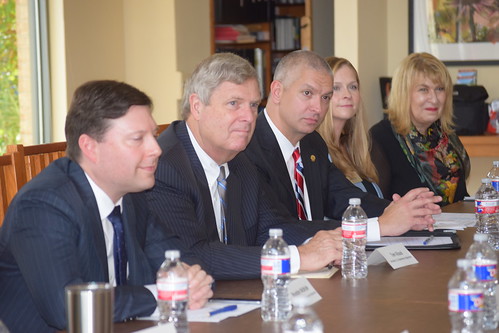
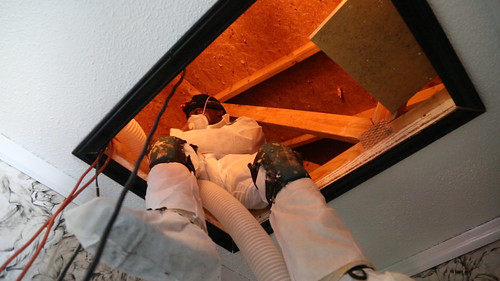
Posted by Brandon McBride, Rural Utilities Service Administrator, on October 26, 2016 at 4:00 PM

Yesterday, Secretary Vilsack and RUS Administrator McBride announced an Energy Efficiency and Conservation Loan Program award to Pedernales Electric Co-op of Johnson City, TX. Left to right: RUS Administrator Brandon McBride, Secretary Vilsack, John Hewa (CEO, Pedernales Electric Cooperative, Inc.), Emily Pataki (Board President, Pedernales Electric Cooperative, Inc.), and Cindy Thyfault (Founder & CEO, Westar Trade Resources)
This is a special year for rural electric cooperative utilities. Eighty years ago, Congress passed and President Roosevelt signed the Rural Electrification Act of 1936.
The REA brought electricity to rural America, ultimately making the United States the source of the world’s food, fuel and fiber—the breadbasket for the world.
Today’s cooperatives not only provide electricity, but build stronger and more vital communities, particularly in rural areas. Rural electric co-ops are leading the way with their commitment to communities, investment in infrastructure to deliver reliable, affordable power and deployment of smart grid technologies, energy efficiency and renewable energy programs.
Energy Efficiency
Rural electric cooperatives are using energy efficiency—the fifth fuel—to reduce power use and costs. Cooperatives have been very strategic in implementing energy efficiency programs to meet growing electric demand and the increasing costs of power, using nearly $127 million of RUS loans to help increase our energy independence and strengthen rural economies.
Smart Grid
To improve electric utility resiliency and efficiency, rural electric cooperatives are investing in smart grid technologies. Co-ops used over $1.5 billion of RUS loans to deploy fiber connections to provide for smart grid needs.
Investments Improve the Quality of Life in Rural America
Rural electric cooperatives are the power that helps drives investment in the rural economy—an investment that builds the foundation for a vibrant future. Since 2009, rural electric cooperatives have invested over $38 billion in rural electric infrastructure, improving over 196,000 miles of line, and connecting 1.5 million new customers.
The economic stability of rural America continues to rely on the availability of affordable and reliable electricity to serve families, businesses, and attract new opportunities to these areas.
Cooperatives understand that America is strongest when we work together. That’s why 80 years after the REA became law, co-ops remain strong and successful.
To find out more about how USDA is Powering America with a More Sustainable Energy Future, visit the latest chapter in our USDA Results page. October is Co-op Month. See Secretary Vilsack’s Proclamation. See today’s electric program award announcement.

RUS Energy Efficiency and Loan Conservation Program can help rural electric consumers reduce energy costs by blowing insulation into an attic, benefitting both rural electric cooperatives and their members. Photo courtesy of North Carolina’s Roanoke Membership Corporation.
Related Posts
Thursday, October 27, 2016
REAPing America’s Clean Energy Future
From the #USDA:
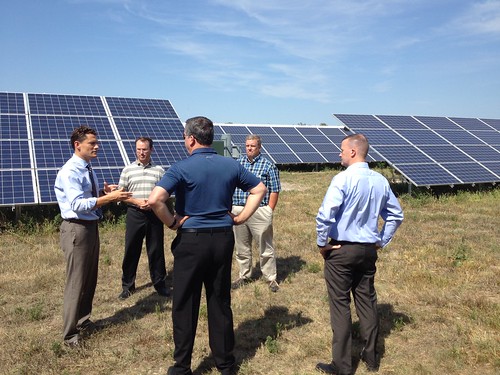
Posted by Sam Rikkers, Administrator for Rural Business and Cooperative Service, on October 25, 2016 at 12:30 PM

Administrator Sam Rikkers (left) discusses the Central City Solar Garden Project with (L-R) City Administrator Chris Anderson, Cliff Mesner of Mesner Development Company (with his back to the camera), and Bill Sheppard and Jeff Carpenter of USDA Rural Development’s Nebraska offices.
USDA Rural Development’s Rural Energy for America Program, commonly referred to as ‘REAP’, provides financial resources for rural agricultural producers and small businesses to help them improve their bottom line. REAP provides loan guarantees and small grants to support these producers and owners as they improve the energy efficiency of their operations and develop renewable energy sources.
Today, Secretary Vilsack announced hundreds of new projects like the one I visited over the summer in Central City, Nebraska. It exemplifies the strategic thinking our rural communities use daily to find new ways to prosper. A community just shy of 3,000 residents, Central City is home to the first community solar garden project ever developed in Nebraska.
Our USDA staff worked with a forward thinking public/private partnership between Cliff Mesner of Mesner Development, and Central City Administrator Chris Anderson to finance the project. Three small businesses: Mesner Development, Co.; Central City Scale, Inc.; and D Bar K, P.C. were awarded small grants they leveraged with low-interest loans from the State of Nebraska’s Energy Office.
Using a concept called ‘virtual net metering’ where the energy produced at the solar array can be applied directly toward the owner’s off-site meter, this partnership has been able to lower electric costs for these businesses, help the environment, and establish an effective price hedge against rising electricity costs. The solar garden initially has eight systems tied together generating nearly 300,000 kWh annually, and the City is planning to develop at least double that amount before the end of 2016.
The business model works like this: The solar panels are owned by what is, essentially, a cooperative partnership comprised of local businesses, individuals, and Central City itself. The array of panels are located in the city’s industrial park, which gives room for growth of the project. Since each of the respective partners own a share of the power, they can assign and reassign it as needed for their homes or businesses, and if they move, they can transfer the power to the new property without having to move the panels.
I spoke with project developer Cliff Mesner about the project, and he pointed out the diversity of ownership, ranging from small business owners looking to improve their bottom line to homeowners – grandmothers, even – who want to use ecologically friendly power sources to preserve the earth for their grandchildren. I’m glad USDA could be a part of making this project possible.
To read more about USDA’s investments in renewable energy and the bio-based economy, visit USDA’s entry on Medium.com, Powering America with a More Sustainable Energy Future.
Related Posts
Tuesday, October 25, 2016
Duke Energy seeks request for proposals - Renewable Energy From Waste
Furthering efforts to provide renewable energy to customers, Duke Energy Carolinas (DEC), Charlotte, North Carolina, issued a request for 750,000 megawatt-hours of energy located in its territory.
Duke Energy seeks request for proposals - Renewable Energy From Waste
Duke Energy seeks request for proposals - Renewable Energy From Waste
Friday, October 14, 2016
Gevo completes production of wood waste-derived jet fuel - Renewable Energy From Waste
Gevo, Inc., Englewood, Colorado, has completed production of cellulosic renewable jet fuel that is specified for commercial flights. Gevo successfully adapted its patented technologies to convert cellulosic sugars derived from wood waste into renewable isobutanol, which was then further converted into Gevo’s alcohol-to-jet fuel (ATJ) fuel. This ATJ meets the ASTM D7566 specification allowing it to be used for commercial flights. The revisions to the ASTM D7566 specification, which occurred earlier this year, includes ATJ derived from renewable isobutanol, regardless of the carbohydrate feedstock (i.e. cellulosics, corn, sugar cane, molasses and so on).
Gevo completes production of wood waste-derived jet fuel - Renewable Energy From Waste
Gevo completes production of wood waste-derived jet fuel - Renewable Energy From Waste
Tuesday, October 11, 2016
UPS Adds 200 Hybrid Electric Vehicles To Alternative Fuel Fleet
UPS (NYSE:UPS) today announced it plans to add 200 new hybrid electric delivery trucks to the company’s growing alternative fuel and advanced technology fleet. The vehicles have the same 2-cylinder engine and E-GENTM chassis as the 125 vehicles UPS announced earlier this year.
UPS Adds 200 Hybrid Electric Vehicles To Alternative Fuel Fleet
UPS Adds 200 Hybrid Electric Vehicles To Alternative Fuel Fleet
Thursday, October 6, 2016
1-megawatt solar system at the Fort Hunter Liggett U.S. Army base
From U.S. Department of Energy Office of Energy Efficiency and Renewable Energy:
This recently installed 1-megawatt solar system at the Fort Hunter Liggett U.S. Army base in#California is one of thousands of #solar #energyprojects going in across the #USA, as costs plummet and technology advances. The Energy Department’s recently released #RevolutionNowreport says that 44% of all solar capacity deployed in #America so far was installed between 2008 and 2015. To continue this U.S. solar surge, our#SunShot Initiative supports work to advance electric grid technologies to accommodate higher levels of solar: http://go.usa.gov/xKJkF.
This recently installed 1-megawatt solar system at the Fort Hunter Liggett U.S. Army base in#California is one of thousands of #solar #energyprojects going in across the #USA, as costs plummet and technology advances. The Energy Department’s recently released #RevolutionNowreport says that 44% of all solar capacity deployed in #America so far was installed between 2008 and 2015. To continue this U.S. solar surge, our#SunShot Initiative supports work to advance electric grid technologies to accommodate higher levels of solar: http://go.usa.gov/xKJkF.
Tuesday, October 4, 2016
High Plains Bioenergy upgrades AD-derived biogas to RNG - Renewable Energy From Waste
High Plains Bioenergy (HPB), with corporate headquarters in Shawnee Mission, Kansas, a subsidiary of Shawnee Mission, Kansas-based Seaboard Foods, plans to upgrade their anaerobic digestion-derived biogas to renewable natural gas using a Carbotech pressure swing adsorption (PSA) system fromBioferm Energy Systems/Viessmann Group, Madison, Wisconsin. Located in Guymon, Oklahoma, HPB currently fuels boilers with the biogas created from the anaerobic digestion of food processing pork waste, but has identified gas upgrading and natural gas grid injection as a better alternative biogas end-use to enable the highest possible return.
High Plains Bioenergy upgrades AD-derived biogas to RNG - Renewable Energy From Waste
High Plains Bioenergy upgrades AD-derived biogas to RNG - Renewable Energy From Waste
The Bio-Based Economy and Renewable Energy: USDA’s Record of Success
From the #USDA:


Posted by Lisa Mensah, Under Secretary, USDA Rural Development, on October 4, 2016 at 11:00 AM

Bear Mountain Forest Products plant owner Bob Sourek in Oregon produces BBQ pellets and home heating fuel pellets. Bear Mountain Bear Bricks (similar to firewood logs), and animal bedding are produced at the Cascade Locks facility.
One of the hallmarks of the Obama Administration has been our commitment to economic growth through an expanding bio-based economy. Nowhere is that transformation more pronounced than the success of renewable energy. And USDA Rural Development has been a leader in that effort.
The proof is in the numbers: Domestic energy-related emissions have fallen to their lowest level in 20 years. Our dependence on foreign oil is at a 40-year low and declining. In the last eight years, USDA has helped lead an effort to promote the domestic production and use of advanced biofuels and biobased products, supporting millions of jobs and pumping hundreds-of-billions-of-dollars into the U.S. economy.
The biobased economy and renewable energy has certainly been a boon to farmers and ranchers. It has also lifted the economic prospects of small and large businesses and created wealth in small towns and communities throughout rural America. Much like our continued commitment to reliable and affordable electricity through our rural electric coops which started more than 80 years ago, USDA’s investments in today’s bio-based economy and renewable energy sources are giving rural America the capacity to thrive.
In February, we visited Bear Mountain Forest Products in my home state of Oregon. Last year, Rural Development provided them with $1,437,305 in Repowering Assistance Program funds to purchase and install a biomass dryer (replacing their propane fueled drying system with a wood fired system). The efficiency upgrade is anticipated to save the company $800,000 per year in operating costs. That’s a big boost to their bottom line, which has allowed them to expand and create even more jobs.
Bear Mountain is part of a bio-based industry that is generating $393 billion for the U.S. economy and contributing over 4.2 million jobs each year.
For farms and small businesses looking to reduce their energy consumption and costs, our signature energy efficiency program, the Rural Energy for America Program (REAP), provides guaranteed loan financing and grant funding to farmers, ranchers and rural businesses to purchase or install renewable energy systems or make energy efficiency improvements. Through this program alone, USDA has assisted over 15,000 rural small businesses, reducing greenhouse emissions that are equivalent to removing almost 1.2 million cars from the road annually.
REAP has supported over 4,000 wind and solar renewable energy projects, enough to power more than 158,000 homes annually and more than 100 anaerobic digesters to help farm operations produce and capture methane to produce electricity.
I am proud of the work we’ve done in Rural Development, and across USDA with investments in today’s bio-based economy and renewable energy sources are giving rural America the capacity to thrive.
To read more about USDA’s record of accomplishment in promoting the bio-based economy and renewable energy, visit our most recent Results Chapter on Medium.

Oregon’s majestic Columbia River Gorge is home to Bear Mountain Forest Products. Creating jobs and vitality to the bio-based economy.
Related Posts
Thursday, September 29, 2016
NREL Report Shows U.S. Solar Photovoltaic Costs Continuing to Fall in 2016
From NREL:
NREL Report Shows U.S. Solar Photovoltaic Costs Continuing to Fall in 2016
SEPTEMBER 28, 2016

NREL U.S. PV system cost benchmarks, from the fourth quarter of 2009 to the first quarter of 2016
|
NREL U.S. PV system cost benchmarks, from the fourth quarter of 2009 to the first quarter of 2016
The modeled costs to install solar photovoltaic (PV) systems continued to decline in the first quarter of 2016 in the U.S. residential, commercial, and utility-scale sectors, according to updated benchmarks from the Energy Department's National Renewable Energy Laboratory (NREL). Driving the cost reductions were lower module and inverter prices, increased competition, lower installer and developer overheads, improved labor productivity, and optimized system configurations.
"The continuing total cost decline of solar PV systems demonstrates the sustained economic competitiveness of solar PV for the industry across all three sectors," said NREL Senior Analyst and Project Lead Ran Fu.
The modeled costs for the first quarter of 2016 were down from the fourth quarter of 2015 by 6 percent, 4 percent, and 20 percent in the residential, commercial, and utility-scale sectors, respectively. The costs fell to $2.93 per watt of direct current for residential systems, $2.13 per watt of direct current for residential systems, and $1.42 per watt of direct current (Wdc) for residential systems for fixed-tilt utility-scale systems, and $1.49 Wdc for one-axis-tracking utility-scale systems.
"Such accurate cost benchmarks are critical for tracking the progress of PV systems toward cost-reduction goals. Because our cost model categorizes hardware and non-hardware costs with a high degree of resolution, the results can also be used to identify specific cost-reduction investment opportunities and assess regional levelized costs of energy," Fu said.
The new results also highlight the importance of non-hardware, or "soft," costs. As the pace of cost reductions for modules and inverters has slowed in recent years, the proportion from soft costs-such as labor, overhead, and permitting costs-has grown. In the first quarter of 2016, soft costs accounted for 58 percent of residential system costs, 49 percent of commercial system costs, and 34 percent of utility-scale system costs.
NREL uses a "bottom-up" modeling method to construct total capital costs by quantifying the typical cost of each individual system and project-development component, largely through dialogues and interviews with solar industry collaborators. The results represent total installed system costs from the perspective of the PV project developer or installer, including net profit in the cost of the hardware. The benchmarks are national averages weighted by state installed PV capacities.
NREL has produced the annual benchmarks since 2009. The full technical report (U.S. Solar Photovoltaic System Cost Benchmark Q1 2016)as well as a presentation about the new results and a data file are available online:
- Full technical report: http://www.nrel.gov/docs/fy16osti/66532.pdf
- Presentation: http://www.nrel.gov/docs/fy16osti/67142.pdf
- Data file: https://doi.org/10.7799/1325002
This ongoing work is supported by the Energy Department's Office of Energy Efficiency and Renewable Energy (EERE) through its SunShot Initiative. SunShot is a collaborative national effort that aggressively drives innovation to make solar energy fully cost-competitive with traditional energy sources before the end of the decade. This research is part of NREL's broader clean energy manufacturing analysis activities, which yield insights that can support Energy Department and industry decisions about research and development targets, investment strategies, and policy evaluation.
NREL is the U.S. Department of Energy's primary national laboratory for renewable energy and energy efficiency research and development. NREL is operated for the Energy Department by The Alliance for Sustainable Energy, LLC.
###
Monday, September 19, 2016
Bank of America Commits to Carbon Neutrality and 100 Percent Renewable Electricity by 2020 | Bank of America Newsroom
New Operations Goals Strengthen the Company’s Ongoing Commitment to Reducing Impact on the Environment
Bank of America Commits to Carbon Neutrality and 100 Percent Renewable Electricity by 2020 | Bank of America Newsroom
Bank of America Commits to Carbon Neutrality and 100 Percent Renewable Electricity by 2020 | Bank of America Newsroom
Saturday, September 3, 2016
Microsoft and Liebherr Collaborating on New Generation of Smart Refrigerators | Cortana Intelligence and Machine Learning Blog
As part of the Liebherr household appliances division’s digital initiative, Liebherr and Microsoft are collaborating in the development of Liebherr’s new generation of the SmartDeviceBox. This is a communication module which fits into Liebherr refrigerators and freezers, connecting them to the internet. The system is designed to have a long lifecycle: Modular units can be integrated and upgraded at any time in existing SmartDevice-ready appliances to create value and comfort for customers through new digital features and solutions.
Microsoft and Liebherr Collaborating on New Generation of Smart Refrigerators | Cortana Intelligence and Machine Learning Blog
Microsoft and Liebherr Collaborating on New Generation of Smart Refrigerators | Cortana Intelligence and Machine Learning Blog
Johnson Controls chooses Azure IoT Suite
Amid growing pressure to reduce global energy consumption, everyone from individual homeowners to large corporations and government agencies are looking for greener ways to manage buildings. Johnson Controls, a leading provider of HVAC equipment and building automation solutions, wanted to create an easier, more-automated way to aggregate data and provide detailed intelligence on systems running in almost any location worldwide.
Johnson Controls chooses Azure IoT Suite
Johnson Controls chooses Azure IoT Suite
Partners join forces to develop robust IoT solutions for smart buildings
IDC projects Internet of Things (IoT) spending to grow from $591.7 billion in 2014 to $1.3 trillion in 2019 with a compound annual growth rate of 17%. Business Insider predicts that there will be 34 billion devices connected to the internet by 2020, up from only 10 billion in 2015. Clearly, IoT is serious business with vast potential yet to be unlocked.
Partners join forces to develop robust IoT solutions for smart buildings
Partners join forces to develop robust IoT solutions for smart buildings
GE's Digital Wind Farm Unlocks Higher Production for Two Aging Plants in Japan
SCHENECTADY, NY—Aug. 25, 2016—GE Renewable Energy (NYSE: GE) announced it has secured five-year Digital Wind Farm services contracts for two aging wind farms in central Japan. Kinden Corporation’s 30 MW Shirama wind farm, a seven-year-old project near Osaka, expects the digital solution will increase the site’s annual energy production (AEP) by up to five percent. A second contract, signed with Kandenko, is expected to deliver up to two percent higher AEP for the 22 MW Chosi project, a twelve-year-old wind farm near Tokyo.
GE's Digital Wind Farm Unlocks Higher Production for Two Aging Plants in Japan
GE's Digital Wind Farm Unlocks Higher Production for Two Aging Plants in Japan
Friday, September 2, 2016
New York passes ‘slow down to get around’ bill - Renewable Energy From Waste
Senate Bill 4168 will require motorists to slow down when passing waste and recycling collection vehicles.
New York passes ‘slow down to get around’ bill - Renewable Energy From Waste
New York passes ‘slow down to get around’ bill - Renewable Energy From Waste
'Biomass day’ planned for coal plant in Oregon - Renewable Energy From Waste
The test day is the first step in converting the Boardman Coal Plant in Boardman, Oregon, into 100 percent biomass, the report says. Portland General Electric (PGE), Portland, Oregon, will use nothing but wood debris to power the station for one full day at the 550-megwatt facility.
'Biomass day’ planned for coal plant in Oregon - Renewable Energy From Waste
'Biomass day’ planned for coal plant in Oregon - Renewable Energy From Waste
Tuesday, August 30, 2016
GE’s Digital Wind Farm Unlocks Higher Production for Two Aging Wind Plants in Japan
From GE:
GE’s Digital Wind Farm Unlocks Higher Production for Two Aging Wind Plants in Japan
August 25, 2016
- GE recently signed new service agreements utilizing Digital Wind Farm technology to boost energy output at two wind projects in central Japan
- Kinden’s 30 MW Shirama wind farm near Osaka expects to add up to five percent more annual energy production, while Kandenko’s 22 MW Chosi wind farm near Tokyo expects to boost production by up to two percent
- Projects will benefit from GE’s Prognostics and PowerUp* Services applications, part of its Digital Wind Farm ecosystem
SCHENECTADY, NY—Aug. 25, 2016—GE Renewable Energy (NYSE: GE) announced it has secured five-year Digital Wind Farm services contracts for two aging wind farms in central Japan. Kinden Corporation’s 30 MW Shirama wind farm, a seven-year-old project near Osaka, expects the digital solution will increase the site’s annual energy production (AEP) by up to five percent. A second contract, signed with Kandenko, is expected to deliver up to two percent higher AEP for the 22 MW Chosi project, a twelve-year-old wind farm near Tokyo.
Anne McEntee, President & CEO of GE’s Onshore Wind business said, “Our Digital Wind Farm concept is starting to gain traction all over the world. These two projects in Japan are great examples of our lifecycle approach to services—we are using data and analytics to create new value from older machines.”
Originally commissioned in 2004, the Chosi wind farm consists of 15 units of GE’s 1.5s product. Using GE’s Prognostics and PowerUp* Services software applications, the site will implement a turbine performance enhancement strategy that involves, among other adjustments, fine tuning the pitch angle according to the site’s real-world operating conditions. The resulting data will help the team analyze current and historical performance, plus it will help predict the remaining useful life of key components in the aging machines. The Kandenko team expects the new technology to boost revenue by up to $650,000 over the remaining lifetime of the project.
Kinden Corporation’s 30 MW Shirama project near Osaka is made up of 20 units of GE’s 1.5sle wind turbines. First commissioned in 2009, the site will also receive GE’s Prognostics and PowerUp* Services applications, implementing software and hardware enhancements that utilize a new blade clearance operation mode which will help the turbines run more efficiently and increase overall plant production by up to five percent.
GE’s Digital Wind Farm concept extends to a wide variety of existing turbine models, and the apps are also compatible with the company’s new 2 MW and 3 MW wind turbines. In May, the company unveiled anew suite of Digital Wind Farm applications that were developed to enhance production and improve wind farm profitability. The programs are built on the Predix* software platform, the foundation for all GE’s Industrial Internet applications, and include its specialized cyber security protection for operational technology.
###
About GE
GE (NYSE: GE) is the world’s Digital Industrial Company, transforming industry with software-defined machines and solutions that are connected, responsive and predictive. GE is organized around a global exchange of knowledge, the "GE Store," through which each business shares and accesses the same technology, markets, structure and intellect. Each invention further fuels innovation and application across our industrial sectors. With people, services, technology and scale, GE delivers better outcomes for customers by speaking the language of industry. www.ge.com
Sunday, August 21, 2016
Developing Battery Technologies
From U.S. Department of Energy Office of Energy Efficiency and Renewable Energy:
The Energy Department supports developing #battery technologies that provide #energy storage to power electric vehicles and stockpile renewable energy resources. This photo shows Energy Department Secretary Ernest Moniz at Argonne National Laboratory in #Illinois, one of our national labs hosting some of the 43 businesses selected to participate in round 2 of our Small Business Vouchers pilot aimed at advancing #cleantechcapabilities: http://go.usa.gov/xDBpP.
The Energy Department supports developing #battery technologies that provide #energy storage to power electric vehicles and stockpile renewable energy resources. This photo shows Energy Department Secretary Ernest Moniz at Argonne National Laboratory in #Illinois, one of our national labs hosting some of the 43 businesses selected to participate in round 2 of our Small Business Vouchers pilot aimed at advancing #cleantechcapabilities: http://go.usa.gov/xDBpP.
Thursday, August 11, 2016
EPA Recognizes U.S. Department of Agriculture Among Nation’s Leading Green Power USERS
From the #USDA:
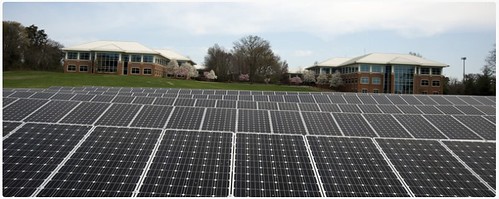
Posted by Dean Johnson, National Facilities Energy and Water Program Manager, USDA Office of Procurement and Property Management, on August 11, 2016 at 10:00 AM

The 1.6 Megawatt solar farm, located at the George Washington Carver Center in Beltsville, Maryland, helps position USDA to meet President Obama’s Executive Order goal to increase the share of electricity the Federal Government consumes from renewable.
In 2015, USDA launched the answer to President Obama’s Climate Action Plan challenge for food and forestry, with the Building Blocks for Climate Smart Agriculture and Forestry. Ten building blocks span a range of technologies and practices to reduce greenhouse gas emissions, increase carbon storage and generate clean renewable energy. Through the Department’s voluntary and incentive-based conservation and energy programs, USDA and its partners are moving forward to reduce net emissions and enhance carbon sequestration by over 120 million metric tons of CO2 equivalent per year, or about 2 percent of economy-wide net greenhouse emissions, by 2025. This reduction is the equivalent of taking 25 million cars off the road or offsetting the emissions produced by powering nearly 11 million homes per year.
In keeping with these efforts, USDA too is working to reduce its own carbon footprint. USDA is proud to be part of the Green Power Partnership, a voluntary program that encourages organizations to use green power as a way to reduce the environmental impacts associated with electricity use. And USDA is even more proud to be recognized as number five on the U.S. Environmental Protection Agency’s (EPA’s) Top 10 Federal Government list of the largest green power users from the Green Power Partnership. Additionally, USDA is number 43 on the National Top 100 list.
USDA is using more than 169 million kilowatt-hours (kWh) of green power annually, which represents 35 percent of its total power needs. And USDA is generating green power from on-site renewable energy including: solar, wind, biomass, hydro and geothermal systems. Because USDA is using green power to advance the green power market and support clean renewable energy alternatives, USDA becomes more sustainable, while also sending a message to others across the United States that using green power is a sound business decision and an important tool in reducing one’s carbon footprint in the fight against climate change.
According to EPA, USDA’s green power use of more than 169 million kWh is equivalent to avoiding the carbon dioxide (CO2) emissions from electricity use of nearly 15,500 average American homes annually. USDA is leading by example for its green power use and for advancing on-site generation.
Green power is zero-emissions electricity that is generated from environmentally preferable renewable resources, such as wind, solar, geothermal, biogas, eligible biomass, and low-impact hydro. Using green power helps build demand for the development of new renewable energy capacity nationwide and helps users reduce their carbon footprints.
In addition to purchasing green power, USDA employs various other sustainable strategies as part of the Department’s operations and practices; including, using alternative fuels in vehicles, designing and constructing high performance green buildings, green purchasing and promoting the use of biobased products. To learn more about USDA’s sustainable operations, please visithttp://greening.usda.gov/.
Currently, this Partnership has more than 1,400 partner organizations that voluntarily use billions of kilowatt-hours of green power annually. Partners include a wide variety of leading organizations such as Fortune 500® companies; small and medium sized businesses; local, state, and federal governments; and colleges and universities. For additional information, please visithttp://www.epa.gov/greenpower.
More information about USDA’s efforts and the results for How Food and Forestry Are Adapting to a Changing Climate is available at https://medium.com/usda-results/how-food-and-forestry-are-adapting-to-a-changing-climate-2f5b84bff9c0#.dn5gf01un.
Related Posts
Thursday, June 30, 2016
REAP: Working Well in North Carolina
From the #USDA:
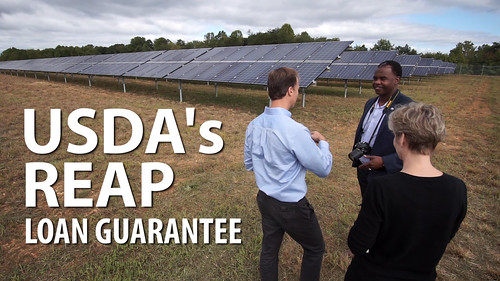
Posted by Sam Rikkers, Administrator, Rural Business and Cooperative Service, on June 29, 2016 at 3:00 PM

Joel Olson (left), President of O2 Energies, Inc. of North Carolina speaks with U.S. Department of Agriculture (USDA) staff in front of one of O2's solar projects. O2 worked with local North Carolina lender Surrey Bank & Trust and USDA Rural Development to finance the project.
USDA Rural Development’s Rural Energy for America Program, or REAP as we call it, is one of the flagship programs found in the energy title of the Farm Bill. Through REAP, USDA helps rural agricultural producers and small businesses improve their financial bottom line through increased energy efficiency and the development of renewable energy sources.
We wanted to share two great examples of this investment and development in North Carolina. In Mt. Airy, NC, local lenders took advantage of REAP’s loan guarantees to finance O2 Energies and build a solar farm that can provide up to 20% of the power needed by the community.
In Mt. Olive, NC, Doug Jernigan used the REAP program to turn his farm’s animal waste into energy. Generating power from poop, Mr. Jernigan puts the energy created back into the grid and offsets the costs associated his ranching operation.
Ultimately, through our loans, grants, and loan guarantees, the USDA REAP program is having a positive impact across the nation – not just by reducing fossil fuel impact and the carbon footprint of rural small businesses and producers – but by supporting jobs and economic investment in the rural communities we serve.
Related Posts
Subscribe to:
Posts (Atom)

